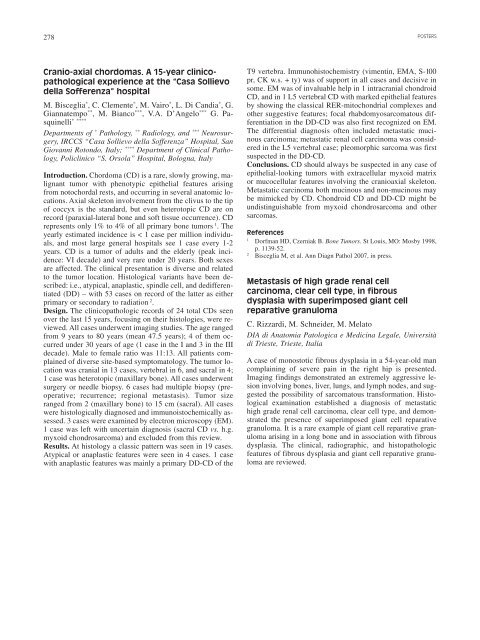Pathologica 4-07.pdf - Pacini Editore
Pathologica 4-07.pdf - Pacini Editore
Pathologica 4-07.pdf - Pacini Editore
Create successful ePaper yourself
Turn your PDF publications into a flip-book with our unique Google optimized e-Paper software.
278<br />
Cranio-axial chordomas. A 15-year clinicopathological<br />
experience at the “Casa Sollievo<br />
della Sofferenza” hospital<br />
M. Bisceglia * , C. Clemente * , M. Vairo * , L. Di Candia * , G.<br />
Giannatempo ** , M. Bianco *** , V.A. D’Angelo *** G. Pa-<br />
* ****<br />
squinelli<br />
Departments of * Pathology, ** Radiology, and *** Neurosurgery,<br />
IRCCS “Casa Sollievo della Sofferenza” Hospital, San<br />
Giovanni Rotondo, Italy; **** Department of Clinical Pathology,<br />
Policlinico “S. Orsola” Hospital, Bologna, Italy<br />
Introduction. Chordoma (CD) is a rare, slowly growing, malignant<br />
tumor with phenotypic epithelial features arising<br />
from notochordal rests, and occurring in several anatomic locations.<br />
Axial skeleton involvement from the clivus to the tip<br />
of coccyx is the standard, but even heterotopic CD are on<br />
record (paraxial-lateral bone and soft tissue occurrence). CD<br />
represents only 1% to 4% of all primary bone tumors 1 . The<br />
yearly estimated incidence is < 1 case per million individuals,<br />
and most large general hospitals see 1 case every 1-2<br />
years. CD is a tumor of adults and the elderly (peak incidence:<br />
VI decade) and very rare under 20 years. Both sexes<br />
are affected. The clinical presentation is diverse and related<br />
to the tumor location. Histological variants have been described:<br />
i.e., atypical, anaplastic, spindle cell, and dedifferentiated<br />
(DD) – with 53 cases on record of the latter as either<br />
primary or secondary to radiation 2 .<br />
Design. The clinicopathologic records of 24 total CDs seen<br />
over the last 15 years, focusing on their histologies, were reviewed.<br />
All cases underwent imaging studies. The age ranged<br />
from 9 years to 80 years (mean 47.5 years); 4 of them occurred<br />
under 30 years of age (1 case in the I and 3 in the III<br />
decade). Male to female ratio was 11:13. All patients complained<br />
of diverse site-based symptomatology. The tumor location<br />
was cranial in 13 cases, vertebral in 6, and sacral in 4;<br />
1 case was heterotopic (maxillary bone). All cases underwent<br />
surgery or needle biopsy. 6 cases had multiple biopsy (preoperative;<br />
recurrence; regional metastasis). Tumor size<br />
ranged from 2 (maxillary bone) to 15 cm (sacral). All cases<br />
were histologically diagnosed and immunoistochemically assessed.<br />
3 cases were examined by electron microscopy (EM).<br />
1 case was left with uncertain diagnosis (sacral CD vs. h.g.<br />
myxoid chondrosarcoma) and excluded from this review.<br />
Results. At histology a classic pattern was seen in 19 cases.<br />
Atypical or anaplastic features were seen in 4 cases. 1 case<br />
with anaplastic features was mainly a primary DD-CD of the<br />
POSTERS<br />
T9 vertebra. Immunohistochemistry (vimentin, EMA, S-100<br />
pr, CK w.s. + ty) was of support in all cases and decisive in<br />
some. EM was of invaluable help in 1 intracranial chondroid<br />
CD, and in 1 L5 vertebral CD with marked epithelial features<br />
by showing the classical RER-mitochondrial complexes and<br />
other suggestive features; focal rhabdomyosarcomatous differentiation<br />
in the DD-CD was also first recognized on EM.<br />
The differential diagnosis often included metastatic mucinous<br />
carcinoma; metastatic renal cell carcinoma was considered<br />
in the L5 vertebral case; pleomorphic sarcoma was first<br />
suspected in the DD-CD.<br />
Conclusions. CD should always be suspected in any case of<br />
epithelial-looking tumors with extracellular myxoid matrix<br />
or mucocellular features involving the cranioaxial skeleton.<br />
Metastatic carcinoma both mucinous and non-mucinous may<br />
be mimicked by CD. Chondroid CD and DD-CD might be<br />
undistinguishable from myxoid chondrosarcoma and other<br />
sarcomas.<br />
References<br />
1 Dorfman HD, Czerniak B. Bone Tumors. St Louis, MO: Mosby 1998,<br />
p. 1139-52.<br />
2 Bisceglia M, et al. Ann Diagn Pathol 2007, in press.<br />
Metastasis of high grade renal cell<br />
carcinoma, clear cell type, in fibrous<br />
dysplasia with superimposed giant cell<br />
reparative granuloma<br />
C. Rizzardi, M. Schneider, M. Melato<br />
DIA di Anatomia Patologica e Medicina Legale, Università<br />
di Trieste, Trieste, Italia<br />
A case of monostotic fibrous dysplasia in a 54-year-old man<br />
complaining of severe pain in the right hip is presented.<br />
Imaging findings demonstrated an extremely aggressive lesion<br />
involving bones, liver, lungs, and lymph nodes, and suggested<br />
the possibility of sarcomatous transformation. Histological<br />
examination established a diagnosis of metastatic<br />
high grade renal cell carcinoma, clear cell type, and demonstrated<br />
the presence of superimposed giant cell reparative<br />
granuloma. It is a rare example of giant cell reparative granuloma<br />
arising in a long bone and in association with fibrous<br />
dysplasia. The clinical, radiographic, and histopathologic<br />
features of fibrous dysplasia and giant cell reparative granuloma<br />
are reviewed.







